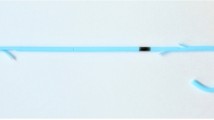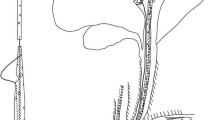Abstract
Background
Although pancreatic duct guidewire placement (P-GW) for achieving selective biliary cannulation is reported to be effective in patients in whom endoscopic retrograde cholangiopancreatography (ERCP) is difficult, this technique entails a possible increased risk of post-ERCP pancreatitis. We conducted a prospective randomized controlled trial to evaluate the prophylactic effect of pancreatic duct stenting on the frequency of post-ERCP pancreatitis in patients who underwent P-GW.
Methods
Seventy patients who underwent P-GW for achieving selective biliary cannulation were included in this study. Patients were randomly assigned to either the stent group (n = 35) or the no-stent group (n = 35). The pancreatic duct stent used was a 5-Fr, 4-cm-long stent with a single pigtail at the duodenal end (Pit-stent™). The primary endpoint was the frequency of post-ERCP pancreatitis.
Results
Selective biliary cannulation was achieved in 80% of the stent group and in 94% of the no-stent group (P = 0.15). Post-ERCP pancreatitis occurred in 13% (9 patients; mild). Pancreatic duct stenting was successful in 91% of the stent group. One patient in the stent group developed migration of the stent during the procedure, followed by mild pancreatitis. The frequency of post-ERCP pancreatitis in the stent group was significantly lower than that in the no-stent group (2.9 vs. 23%, relative risk 0.13, confidence interval 0.016, 0.95).
Conclusion
Pancreatic duct stenting after P-GW for achieving selective biliary cannulation is recommended to reduce the incidence of post-ERCP pancreatitis.





Similar content being viewed by others
References
Freeman ML, Guda NM. ERCP cannulation: a review of reported techniques. Gastrointest Endosc. 2005;61:112–25.
Artifon ELA, Sakai P, Cunha JEM, Halwan B, Ishioka S, Kumar A. Guidewire cannulation reduces risk of post-ERCP pancreatitis and facilitates bile duct cannulation. Am J Gastroenterol. 2007;102:2147–53.
Dumonceau JM, Deviere J, Cremer M. A new method of achieving deep cannulation of the common bile duct during endoscopic retrograde cholangiopancreatography. Endoscopy 1998;30:S80.
Gotoh Y, Tamada K, Tomiyama T, Wada S, Ohashi A, Satoh Y, et al. A new method for deep cannulation of the common bile duct during endoscopic retrograde cholangiopancreatography. Endoscopy. 2001;53:820–2.
Hayashi H, Maeda S, Hosokawa O, Doden K, Hattori M, Tanikawa Y, et al. A technique for selective cannulation of the common bile duct in endoscopic retrograde cholangiopancreatography. Insertion of guide wire into the pancreatic duct (in Japanese with English abstract). Gastroenterol Endosc. 2001;43:828–32.
Maeda S, Hayashi H, Hosokawa O, Dohden K, Hattori M, Morita M, et al. Prospective randomized pilot trial of selective biliary cannulation using pancreatic guide-wire placement. Endoscopy. 2003;35:721–4.
Cotton PB, Lehman G, Vennes J, Geene JE, Russell RC, Meyers WC, et al. Endoscopic sphincterotomy complications and their management: an attempt at consensus. Gastrointest Endosc. 1991;37:383–93.
Freeman ML, DiSario JA, Nelson DB, Fennerty MB, Lee JG, Bjorkman DJ, et al. Risk factors for post-ERCP pancreatitis: a prospective, multicenter study. Gastrointest Endosc. 2001;54:425–34.
Tarnasky PR, Palesch YY, Cunningham JT, Mauldin PD, Cotton PB, Hawes RH. Pancreatic stenting prevents pancreatitis after biliary sphincterotomy in patients with sphincter of Oddi dysfunction. Gastroenterology. 1998;115:1518–24.
Fazel A, Quadri A, Catalano MF, Meyerson SM, Geenen JE. Does a pancreatic duct stent prevent post-ERCP pancreatitis? A prospective randomized study. Gastrointest Endosc. 2003;57:291–4.
Harewood GC, Ponchron NL, Gostout CJ. Prospective, randomized, controlled trial of prophylactic pancreatic stent placement for endoscopic snare excision of the duodenal ampulla. Gastrointest Endosc. 2005;62:367–70.
Tsuchiya T, Itoi T, Sofuni A, Itokawa F, Kurihara T, Ishii K, et al. Temporary pancreatic stent to prevent post endoscopic retrograde cholangiopancreatography pancreatitis: a preliminary, single-center, randomized controlled trial. J Hepatobiliary Pancreat Surg. 2007;14:302–7.
Sofuni A, Maguchi H, Itoi T, Katanuma A, Hisai H, Niido T, et al. Prophylaxis of post-endoscopic retrograde cholangiopancreatography pancreatitis by an endoscopic pancreatic spontaneous dislodgement stent. Clin Gastroenterol Hepatol. 2007;5:1339–46.
Fujita N, Noda Y, Kobayashi G, Kimura K, Yago A. ERCP for intradiverticular papilla two-devices-in-one-channel method. Gastrointest Endosc. 1998;48:517–20.
Tejada AH, Calleja JL, Diaz G, Pertejo V, Espinel J, Cacho G, et al. Double-guidewire technique for difficult bile duct cannulation: a multicenter randomized, controlled trial. Gastrointest Endosc. 2009;70:700–9.
Cote GA, Ansstas M, Pawa R, Edmundowicz SA, Jonnalagadda SS, Pleskow DK, et al. Difficult biliary cannulation: use of physician-controlled wire-guided cannulation over a pancreatic duct stent to reduce the rate of precut sphincterotomy (with video). Gastrointest Endosc. 2010;71:275–9.
Cheng CL, Sherman S, Watkins JL, Barnett J, Freeman M, Geenen J, et al. Risk factors for post-ERCP pancreatitis: a prospective multicenter study. Am J Gastroenterol. 2006;101:139–47.
Acknowledgments
The authors are indebted to Mr. Thomas Mandeville for reviewing this manuscript.
Conflict of interest statement
None.
Author information
Authors and Affiliations
Corresponding author
Rights and permissions
About this article
Cite this article
Ito, K., Fujita, N., Noda, Y. et al. Can pancreatic duct stenting prevent post-ERCP pancreatitis in patients who undergo pancreatic duct guidewire placement for achieving selective biliary cannulation? A prospective randomized controlled trial. J Gastroenterol 45, 1183–1191 (2010). https://doi.org/10.1007/s00535-010-0268-7
Received:
Accepted:
Published:
Issue Date:
DOI: https://doi.org/10.1007/s00535-010-0268-7




